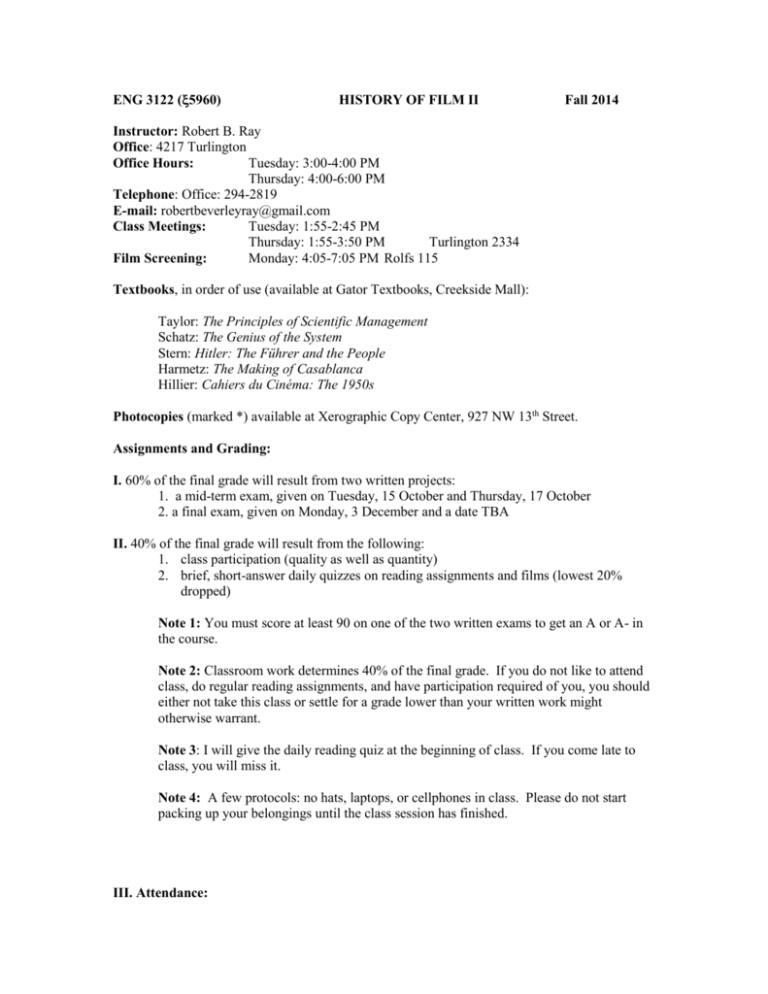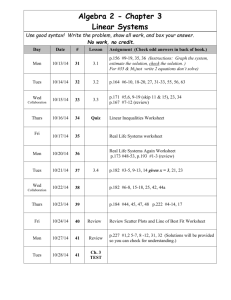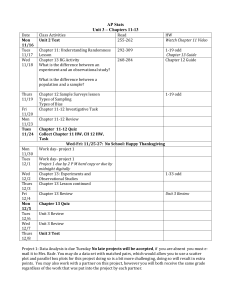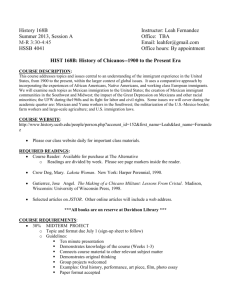ENG 3122, Section 5960, Ray
advertisement

ENG 3122 (5960) HISTORY OF FILM II Fall 2014 Instructor: Robert B. Ray Office: 4217 Turlington Office Hours: Tuesday: 3:00-4:00 PM Thursday: 4:00-6:00 PM Telephone: Office: 294-2819 E-mail: robertbeverleyray@gmail.com Class Meetings: Tuesday: 1:55-2:45 PM Thursday: 1:55-3:50 PM Turlington 2334 Film Screening: Monday: 4:05-7:05 PM Rolfs 115 Textbooks, in order of use (available at Gator Textbooks, Creekside Mall): Taylor: The Principles of Scientific Management Schatz: The Genius of the System Stern: Hitler: The Führer and the People Harmetz: The Making of Casablanca Hillier: Cahiers du Cinéma: The 1950s Photocopies (marked *) available at Xerographic Copy Center, 927 NW 13th Street. Assignments and Grading: I. 60% of the final grade will result from two written projects: 1. a mid-term exam, given on Tuesday, 15 October and Thursday, 17 October 2. a final exam, given on Monday, 3 December and a date TBA II. 40% of the final grade will result from the following: 1. class participation (quality as well as quantity) 2. brief, short-answer daily quizzes on reading assignments and films (lowest 20% dropped) Note 1: You must score at least 90 on one of the two written exams to get an A or A- in the course. Note 2: Classroom work determines 40% of the final grade. If you do not like to attend class, do regular reading assignments, and have participation required of you, you should either not take this class or settle for a grade lower than your written work might otherwise warrant. Note 3: I will give the daily reading quiz at the beginning of class. If you come late to class, you will miss it. Note 4: A few protocols: no hats, laptops, or cellphones in class. Please do not start packing up your belongings until the class session has finished. III. Attendance: You are allowed two unexcused absences. Each additional absence on a Tuesday will subtract 4 points from your final course grade; a Thursday absence will cost 7 points. If you arrive significantly late or leave after the break on Thursday, you will lose 3 points. ********* In the sixteenth century, an Italian named Giulio Camillo constructed an object that became the talk of Western Europe. He called his work “The Memory Theater,” and he took it on tours of Venice and Paris, where he announced that he would reveal his building’s secret to only one person, the King of France, and only in a book, which he promised. Camillo, however, never completed the book, leaving behind only his theater, a wooden model, large enough to admit at least two people at once. Camillo’s theater was, in fact, another version of a memory system, first described by the Roman writer Cicero, a mnemonic technique that links ideas or topics to specific places or objects. Cicero’s account connects this technique’s origins to treachery and catastrophe: invited by a nobleman to recite at a banquet, a poet named Simonides, having completed his oration, was told by his host that he would receive only half the agreed-upon payment for his work. A few minutes later, a message arrived for Simonides: two men were waiting outside to see him. He left the table and went out, but found no one. In his absence, the roof of the banquet hall collapsed, crushing the host and the remaining guests, so mangling the corpses as to leave them unidentifiable, even by relatives. Simonides, however, remembering the places where the guests had been sitting, was able to indicate to the mourners which were their dead. In Cicero’s words: He inferred that persons desiring to train this faculty (of memory) must select places and form mental images of the things they wished to remember and store those images in the places, so that the order of the places will preserve the order of the things, and the images of the things will denote the things themselves, and we shall employ the places and images respectively as a wax writing-tablet and the letters written on it. This course asks you to use the movie Casablanca as a memory theater for storing and recalling (1) the events of the 1930s, especially the two that will concern us – the consolidation of the Hollywood studio system and the rise of German fascism; and (2) the course of post-War cinematic history, especially American film noir, Italian neorealism, and the French New Wave. After beginning with two films with German origins, Fritz Lang’s M and MGM’s Grand Hotel, the course’s first half will trace the parallel developments in Hollywood and Europe, using the biography and writings of Walter Benjamin as an allegory of popular culture’s appeal and Naziism’s danger. Part I ends with the Fall of Paris, both the historical event (which drove Benjamin further into a fatal exile) and its Hollywood representation (in Casablanca). Part II traces the two roads that diverge from that moment: the film noir of movies like In a Lonely Place and the neorealist rejection of Hollywood Cinema. These two filmmaking practices, apparently so contradictory, converge in the French New Wave, whose most famous movie, Jean-Luc Godard’s Breathless, explicitly invokes the image of Humphrey Bogart, the star of Casablanca. PART I – FROM HITLER TO CASABLANCA Aug. 26 (Tues.): Introduction Aug. 28 (Thurs.): The Gospel of Efficiency Taylor: The Principles of Scientific Management, pp. 5-48, 59-71, 77-97, 117-118, 126128, 130 (84 pages) Sept. 2 (Tues.): Mechanization Takes Command: Fordism *Batchelor: Henry Ford: Mass Production, Modernism and Design, pp. 1-6, 13-37, 3963, 66-70 (40 pages) Sept. 4 (Thurs.): The Culture Factory: Hollywood’s Studio System Schatz: The Genius of the System, pp. 3-66 (64 pages) 42nd Street (1933: Lloyd Bacon; 89 minutes) [see by this date] Sept. 9 (Tues.): Warner Brothers and MGM Schatz: The Genius of the System, pp. 98-124, 135-175 (68 pages) Sept. 11 (Thurs.): Germany in the 1930s: Hitler * Hughes: from Contemporary Europe: A History, pp. 234-243, 245-250 (16 pages) [recommended for historical context] Stern: Hitler: The Führer and the People, pp. 1-53, 64-82 (72 pages) Sept. 16 (Tues.): Fritz Lang and the European Emigration to Hollywood *Taylor: from Strangers in Paradise: The Hollywood Emigrés, pp. 15-40, 43-55 (49 pages) Sept. 18 (Thurs.): Aesthetics and Politics in Germany: Walter Benjamin and Bertolt Brecht *Roberts: from Walter Benjamin, pp. 13-20 [“Benjamin’s Life”] (8 pages) *Demetz: from Reflections, pp. vii-xv [“Introduction”] (9 pages) *Benjamin: from Illuminations, pp. 217-251 [“The Work of Art in the Age of Mechanical Reproduction”] (35 pages) *Brecht: from Brecht on Theatre, pp. 33-49 [“The Modern Theatre is the Epic Theatre”; “The Literarization of the Theatre”; “The Film, the Novel and Epic Theatre”] (17 pages) Sept. 23 (Tues.): Germany in the 1930s: Modernism and Technology *Hughes: from Contemporary Europe: A History, pp. 295-320 (26 pages) *Wollen: from Raiding the Icebox, pp. 1-71 (71 pages) Sept. 25 (Thurs.): French “Poetic Realism” and Jean Renoir *Hughes: from Contemporary Europe: A History, pp. 250-254 (5 pages) *Braudy: from Jean Renoir, pp. 194-218 [“Biographical Sketch”] (25 pages) *Bergan: from Jean Renoir, pp. 205-206 (2 pages) *Renoir: from Renoir on Renoir, pp. 168-210, 227-229, 232-233, 236-239 [“Jean Renoir the boss”] (42 pages) Sept. 30 (Tues.): Renoir, the Archive, and Contingency *Roud: A Passion for Films: Henri Langlois and the Cinémathèque Française, pp. xxiii-57 (63 pages) Oct. 2 (Thurs.): Renoir, Continued *Burch: “Chance and Its Functions,” from Theory of Film Practice, pp. 105-121 (17 pages) Oct. 7 (Tues.): Hollywood in the 1930s and Warner Brothers in the 1940s Schatz: The Genius of the System, pp. 199-227, 252-270, 297-321 (72 pages) Oct. 9 (Thurs.): Warner Brothers, The Fall of Paris, and the White Rose *Stern: from The Heart of Europe, pp. 192-212 [“The White Rose”] (21 pages) Harmetz: The Making of Casablanca, pp. 3-100 (98 pages) Oct. 14 (Tues.): Everyone Comes to Rick’s – Casablanca-as-Memory Theatre Harmetz: The Making of Casablanca, pp. 102-283 (182 pages) Oct. 16 (Thurs.): Casablanca and Hollywood’s Studio Style No additional reading Oct. 21 (Tues.): Mid-Term Exam Part I Oct. 23 (Thurs.): Mid-Term Exam Part II PART II – FILM NOIR AND NEOREALISM TO BREATHLESS Oct. 28 (Tues.): Film Noir Schatz: The Genius of the System, pp. 411-439 (29 pages) *Cook: from A History of Narrative Film, pp. 464-479 (16 pages) *Vernet: “Film Noir on the Edge of Doom” (31 pages) Love Finds Andy Hardy (1938: George B. Seitz; 90 minutes) (See by this date.) It’s a Wonderful Life (1946: Frank Capra; 129 minutes) (See by this date.) Oct. 30 (Thurs.): Film Noir and Existentialism *Sartre: “The Wall” (17 pages) *Sartre: Existentialism is a Humanism” (25 pages) Nov. 4 (Tues.): Italian Neorealism: The Manifesto *Hughes: from Contemporary Europe: A History, pp. 362-364 (3 pages) *Cook: from A History of Narrative Film, pp. 437-456 (20 pages) *Overbey: from Springtime in Italy: A Reader on Neo-Realism, pp. 1-33 [“Introduction”] (33 pages) *Zavattini: “A Thesis on Neo-Realism” (12 pages) Nov. 6 (Thurs.): Italian Neorealism, Continued Hillier: Cahiers du Cinéma – The 1950s: Neo-Realism, Hollywood, New Wave, pp. 175-178, 180-181, 192-203, 206-207, 209-214 (26 pages) Nov. 11 (Tues.): Veterans’ Day – No Class Nov. 13 (Thurs.): Neorealism, Continued Hillier: Cahiers du Cinéma – The 1950s: Neo-Realism, Hollywood, New Wave, pp. 1-14, 21-26, 28-30, 51, 73-83, 98-101, 116-119, 221-225, 248-258, 284-288 (64 pages) Nov. 18 (Tues.): La Politique des Auteurs *Truffaut: “A Certain Tendency of the French Cinema” (14 pages) *Truffaut: from The Early Film Criticism of François Truffaut, pp. 73, 85-87, 154 (5 pages) Nov. 20 (Thurs.): Godard I *Godard: Three Interviews about Breathless (6 pages) *Godard: “Interview with Jean-Luc Godard” (26 pages) *Godard: “Pierrot my friend” (3 pages) *Godard: “Let’s Talk about Pierrot” (19 pages) *Godard: “Speech delivered at the Cinémathèque Française” (4 pages) *Godard: “One Should Put Everything into a Film” (2 pages) Nov. 25 (Tues.): Thanksgiving Week – No Class Dec. 2 (Tues.): Truffaut *Davis: “Interview with François Truffaut” (10 pages) * Baby: “I Wanted to Treat Shoot the Piano Player like a Tale by Perrault” (2 pages) *Truffaut: “Adopting Shoot the Piano Player” (3 pages) Dec. 4 (Thurs.): Godard II *Wollen: “Godard and Counter Cinema: Vent d’Est” (13 pages) *Daix: “An Interview with Jean-Luc Godard” (14 pages) Dec. 8 (Mon.): Final Exam Part I Dec. 9 (Tues.): Final Exam Part II FILM SCREENINGS – PART I Aug. 25 (Mon.): Grand Hotel (1932: Edmund Goulding; 113 minutes) Sept. 1 (Mon.): Labor Day – No Screening Sept. 8 (Mon.): M (1931: Fritz Lang; 118 minutes) Triumph of the Will (1935: Leni Riefenstahl; 110 minutes) [Excerpts] Sept. 15 (Mon.): Le Crime de Monsieur Lange (1936: Jean Renoir; 90 minutes) Une Partie de Campagne [A Day in the Country] (1946: Jean Renoir; 40 minutes) Sept. 22 (Mon.): Rules of the Game (1939: Jean Renoir; 113 minutes) Sept. 29 (Mon.): The Maltese Falcon (1941: John Huston; 100 minutes) Oct. 6 (Mon.): Casablanca (1942: Michael Curtiz; 102 minutes) Oct. 13 (Mon.): In a Lonely Place (1950: Nicholas Ray; 91 minutes) FILM SCREENINGS – PART II Oct. 20 (Mon.): The Narrow Margin (1952: Richard Fleischer; 70 minutes) Oct. 27 (Mon.): Paisa [sections 1 and 6] (1946: Roberto Rossellini; 40 minutes) Rome, Open City (1945: Roberto Rossellini; 105 minutes) Nov. 3 (Mon.): The Bicycle Thief (1949: Vittorio De Sica; 90 minutes) Les Mistons (1957: Francois Truffaut; 26 minutes) Nov. 10 (Mon.): Breathless (1959: Jean-Luc Godard; 89 minutes) Nov. 17 (Mon.): Shoot the Piano Player (1960: François Truffaut; 81 minutes) Dec. 1 (Mon.): Masculin-Féminin [Masculine-Feminine] (1965: Jean-Luc Godard; 110 minutes)







